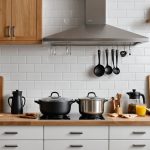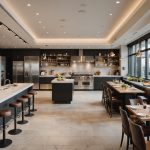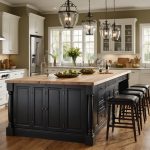Open kitchen designs have become a hallmark of modern restaurants. They transform the dining experience by allowing guests to witness the culinary magic happening right before their eyes. This layout invites patrons into the heart of the restaurant, bridging the gap between the food they eat and the hands that prepare it. However, while these designs may enhance the dining experience, they also come with their own set of challenges. In this article, we will explore the pros and cons of open kitchen designs in restaurants, giving you the insights you need to decide if this layout suits your business.
The Benefits of Open Kitchen Designs
An open kitchen design offers several advantages that can significantly enhance the restaurant experience. One of the most notable benefits is the transparency it provides. Guests can see their food being prepared, which fosters a sense of trust in the restaurant’s practices. Knowing that dishes are being crafted with care can reassure customers about the quality of the food they are about to enjoy.
In parallel : How can you utilize customer loyalty programs to boost sales in your bar?
Moreover, open kitchens often create a vibrant atmosphere. The cooking process itself can be mesmerizing, and the sounds of sizzling pans and chopping knives can add to the overall dining experience. This dynamic environment can encourage customers to stay longer, potentially increasing their spending.
The efficiency of an open kitchen layout also cannot be overlooked. With a well-designed workflow, staff can move seamlessly between various stations such as preparation, cooking, and assembly. This can lead to faster service, as the distance between the dining area and food preparation is minimized. An efficient layout can also streamline communication among the staff, reducing the risk of miscommunication and errors during busy service times.
Also read : What are the challenges of running a family-owned restaurant in the UK?
Furthermore, open kitchens promote creativity. Chefs often thrive in environments where they can showcase their skills. This visibility can lead to innovative dishes and cooking techniques that might not be as prevalent in a traditional, closed-off kitchen. As customers see the artistry involved in their meals, they may feel a deeper connection to the food, enhancing their overall dining experience.
Challenges of Open Kitchen Designs
While open kitchen designs offer many benefits, they also come with inherent challenges that restaurant owners must consider. One major concern is the hygiene aspect. An open kitchen exposes food preparation to the dining area, which can lead to increased scrutiny from customers. This exposure means that kitchen storage and cleanliness must be maintained at a higher standard, as any lapse in hygiene practices will be visible to guests. A single mishap could tarnish the restaurant’s reputation.
Noise levels can also be a considerable drawback. The sounds of cooking, talking between staff, and the general hustle and bustle of an open kitchen can create an overwhelming auditory experience for diners. If not managed properly, excessive noise can disrupt the dining experience, making it difficult for customers to engage in conversation.
Another challenge relates to space management. Open kitchens require a significant amount of room to accommodate cooking equipment, stations, and staff movements. In smaller establishments, this can lead to cramped conditions, impacting both the efficiency of the kitchen and the comfort of guests in the dining area. Moreover, the layout must be meticulously planned to ensure that workflow is not hindered by the physical space constraints.
The visibility of the staff also raises concerns regarding professionalism. Chefs and kitchen staff may feel pressured to perform at their best at all times, as diners can see every action. This pressure can lead to stress and anxiety, potentially impacting the quality of food and service. Furthermore, the need for a polished performance might detract from the authenticity of the kitchen experience, which is something many diners appreciate.
Design Considerations for Open Kitchens
When contemplating an open kitchen design, careful attention must be paid to various design aspects. First, consider the layout to ensure an efficient workflow. The kitchen should be organized in a manner that minimizes unnecessary movements. For instance, placing the assembly station close to cooking areas can reduce the time it takes to serve hot dishes to diners. This design consideration can significantly impact the overall efficiency of the restaurant.
The choice of equipment is also crucial. High-quality, professional-grade appliances can enhance performance and ensure that food is prepared quickly and to a high standard. Investing in proper ventilation systems is vital in open kitchens, as it helps to control cooking odors and smoke, ensuring that the dining area remains a pleasant space for customers.
Another design consideration is the aesthetic appeal of the kitchen. An open kitchen can serve as a focal point in the restaurant, so it should be visually appealing. Consider using materials and finishes that reflect the restaurant’s theme while also ensuring they are easy to clean and maintain. This integration of style and function will enhance the overall experience for diners.
Lastly, sound management is an essential aspect of open kitchen design. Installing sound-absorbing materials can help to mitigate excessive noise levels, ensuring that the dining atmosphere remains enjoyable. Strategically placing barriers or acoustic panels can aid in creating a balance between an engaging kitchen experience and a serene dining environment.
Customer Perspectives on Open Kitchens
Understanding customer perspectives on open kitchens is vital for restaurant owners. Many diners appreciate the transparency offered by an open kitchen. Guests often enjoy watching chefs at work, as it provides an experience that goes beyond just eating food. The visual connection to the cooking process enhances their appreciation for the meal and can result in a more memorable dining experience.
However, some diners may feel uncomfortable with the visibility of kitchen operations. For instance, witnessing the chaotic moments during busy service times can deter some customers. Staff interactions, whether positive or negative, can influence customer perceptions of the restaurant’s quality. A well-coordinated team can create a positive atmosphere, while visible stress or disarray can have the opposite effect.
Moreover, customers are increasingly conscious of hygiene and food safety standards. Many diners may scrutinize the cleanliness of an open kitchen more than they would a traditional kitchen. Therefore, it is essential for restaurant staff to be consistently vigilant about cleanliness and organization to maintain a positive customer perception.
Finally, customers’ preferences can vary. Some patrons may prefer the traditional restaurant experience that separates the dining area from the kitchen, while others actively seek out restaurants with an open kitchen model. This difference in preferences means that understanding your target audience is crucial when deciding on the layout of your restaurant.
In conclusion, the decision to implement an open kitchen design in your restaurant comes with both pros and cons. While the transparency, vibrant atmosphere, and potential for enhanced efficiency can elevate the dining experience, challenges such as hygiene concerns, noise levels, and the need for meticulous space management cannot be ignored. It is crucial to weigh these factors carefully in light of your restaurant’s goals and target audience. By considering the insights shared in this article, you can make informed decisions about whether an open kitchen design aligns with your vision for culinary excellence.











